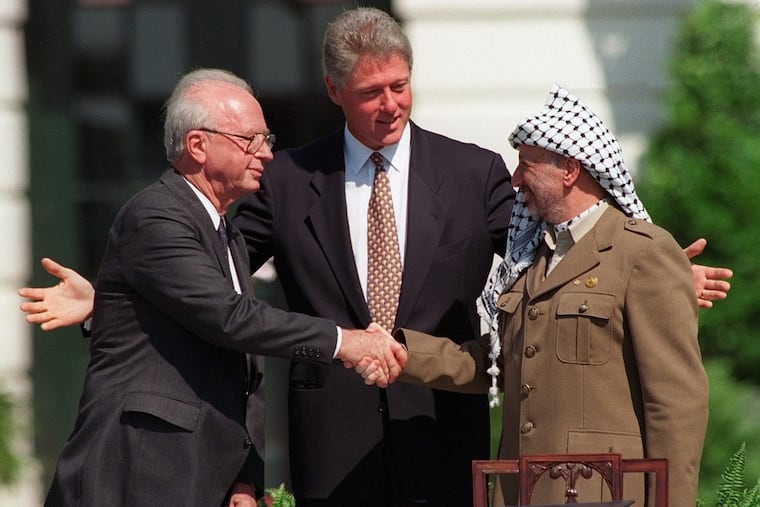Mideast peace ‘deal of century’ eludes Trump, 25 years after Oslo Accords | Trudy Rubin
Trump has openly rejected all of the Oslo Accord's 's core elements, but what we know of his much awaited "peace plan" basically endorses a permanent apartheid-like Israeli state.

Twenty-five years ago today I stood on the White House lawn and watched the famous handshake between Israeli Prime Minister Yitzhak Rabin and Palestinian leader Yasir Arafat, as President Bill Clinton nudged them toward each other. The occasion was the signing of the 1993 Oslo Accords, mapping a path to a two-state solution with Israel and Palestine living peacefully side-by-side.
The Oslo process failed, with plenty of blame on both sides.
Yet President Trump has rashly pledged a "deal of the century" that he says will produce Mideast peace. His negotiators – led by First Son-in-Law Jared Kushner — keep promising to unveil their plan soon, but the thrust is already clear: A series of punitive U.S. measures against Palestinians (the latest: the closure of the Palestine Liberation Organization's office in Washington this week) appear aimed at forcing them to abandon the Oslo promise of statehood.
Trump's coercive diplomacy has been rejected by Palestinian leaders (and has yet to receive buy-in even from Arab leaders friendly to Israel). And it ignores the demographic reason a reluctant Rabin and subsequent Israeli premiers – until Benjamin Netanyahu — accepted the premise of Oslo: If Palestinian sovereignty is ruled out, a majority of Israeli Jews will retain permanent control over a disenfranchised majority of Arabs. This is the road to an apartheid-style Israeli state.
Yet the Trump team seems determined to dismantle every premise of the Oslo Accords, and reshape a peace framework that parallels Netanyahu's demands.
"The Trump moves can't be seen in a vacuum," says Aaron David Miller, a vice president at the Woodrow Wilson Center and an adviser on Israeli-Palestinian negotiations to both Republican and Democratic secretaries of state. Trump's "broader objective," Miller says, "is to reframe U.S. policy for a two-state solution." Trump wants to dismantle three core elements of the Oslo process: Jerusalem, the issue of Palestinian refugees, and the division of territory into two states.
In recent months the president has made the following unilateral moves:
On Jerusalem: Trump declared that this critical issue has been taken "off the table" – meaning little or no possibility that the Palestinians could have their capital in Arab areas of East Jerusalem in an undivided city.
On Palestinian refugees: Trump is trying to limit the definition of Palestinian refugees to those who fled or were driven out of Palestine in 1947-48, not including their descendants. He has ended the U.S. contribution to the U.N. Relief and Works Agency (UNRWA), the Palestinian refugee agency. These moves are meant to end discussion of any "right of return" for millions of Palestinian refugees to Israel.
In truth, no solution was ever possible unless the Palestinians reduced this demand to a symbolic "return;" Palestinian refugees should have been resettled long ago. But U.S. diktats aren't going to resolve the problem of hundreds of thousands of refugees who still live in camps in Arab countries that are drowning in new waves of Syrian refugees. With no Palestinian state to return to, where will the refugees go? And Trump can hardly request third countries to resettle these Palestinians when he is trying to zero out American acceptance of any refugees at all.
On the two-state solution: The most basic White House rejection of Oslo is its redefinition of a two-state solution. Kushner appears to have bought into Netanyahu's concept of a "state-minus." This means that Palestinians would only be given local autonomy over around 40 percent of West Bank land – in disconnected chunks – which means they could administer local services but would have no broader sovereign rights. Gaza would nominally be under control of Palestinian leadership, but Israel would control security; most land, sea, and air access; electricity; and trade.
"It would not be the Palestinian idea of a state," says Ofer Zalzberg, the International Crisis Group's senior analyst for Israel/Palestine, who lives in Jerusalem. "But the United States could frame it as a state with provisional borders, or a state-minus." However, Israel would control the remaining 60 percent of West Bank land, within which Israeli settlements could expand unimpeded.
Some Israeli leaders want to annex the 60 percent, known as Area C, or even the whole West Bank. However, that would raise the question of giving Palestinians Israeli citizenship, which Netanyahu wants to avoid, since Arab voters could ultimately outnumber Jews.
Instead, the Kushner plan focuses on a pretend "state," as does Netanyahu.
The Kushner sweetener would apparently be a large dose of economic aid to the West Bank and Gaza to make Palestinian lives easier. Yet past experience has shown that the West Bank and Gaza economies can't thrive when the political future of those areas remains uncertain.
"To achieve long-term calm, the question of citizenship must be addressed," says Zalzberg, "and this is still missing."
A "state-minus" – unless it leaves open the prospect of sovereignty in the future – will leave Israel ruling over a disenfranchised Arab majority between the Jordan River and the Mediterranean.
Trump may not care or may not know this. But, without confronting this reality, his "deal of the century" will fail.